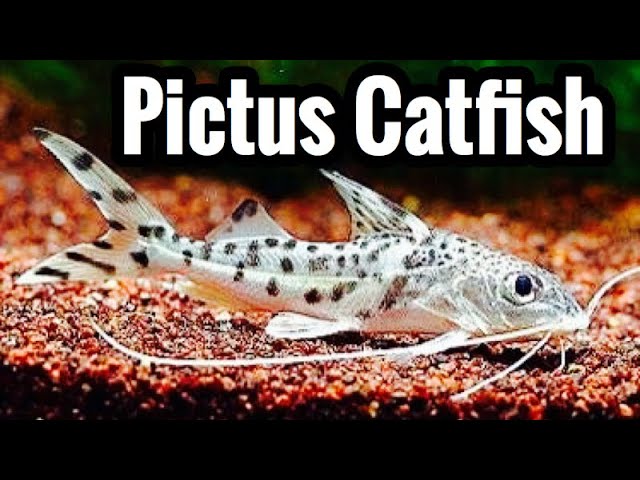The Pictus Catfish: A Fascinating Aquatic Companion
The Pictus Catfish, scientifically known as Pimelodus Pictus, is a captivating and sought-after addition to the world of aquarium enthusiasts. In this comprehensive guide, we dive into the captivating world of Pictus Catfish, exploring their unique characteristics, ideal care practices, and the joy they bring to aquariums.
Pictus Catfish Profile: Discovering Their Unique Features

pictus catfish
Pictus Catfish Characteristics:
These delightful catfish sport a sleek, elongated body adorned with distinctive patterns of black spots against a silvery-white background. Measuring around 4 to 6 inches in length, their torpedo-shaped form is both elegant and streamlined.
Natural Habitat:
In their native South American waters, Pictus Catfish thrive in river basins with moderate to fast currents. Understanding their natural habitat is crucial for replicating suitable conditions in captivity.
Pictus Catfish Care: Creating the Perfect Aquarium Home
Setting Up the Perfect Aquarium:
To ensure the well-being of your Pictus Catfish, it’s essential to recreate their natural habitat in your aquarium. Opt for a spacious tank with a smooth gravel substrate, ample hiding spots, and live plants to mimic their riverine environment.
Water Conditions:
Maintaining optimal water conditions is critical. Aim for a pH level between 6.5 to 7.5, a temperature range of 74-79°F (23-26°C), and pristine water quality with regular filtration and water changes.
Diet and Feeding:
Pictus Catfish are voracious eaters. They thrive on a diet of high-quality pellets, frozen or live foods like bloodworms and brine shrimp, and the occasional vegetable matter to keep them healthy and vibrant.
Compatibility with Other Fish: Building a Harmonious Aquarium Community
Community Tank Potential:
Pictus Catfish are known for their peaceful disposition, making them suitable for community tanks. However, it’s essential to choose tankmates wisely, opting for species that share their peaceful temperament and can coexist harmoniously.
Tankmates:
When selecting tankmates for your Pictus Catfish, consider companions such as tetras, gouramis, and other non-aggressive species. Avoid aggressive or overly territorial fish that may stress or harm your Pictus Catfish.
Behavior and Temperament: Understanding Your Pictus Catfish
Pictus Catfish Behavior:
These catfish are known for their active and social nature. They often dart around the tank, exploring their surroundings and interacting with tankmates. Observing their behavior can be a source of fascination for aquarists.
Handling Stress:
To keep your Pictus Catfish stress-free, provide ample hiding places, maintain stable water conditions, and avoid sudden changes in lighting or tank setup. Minimizing stress is essential for their overall well-being.
Common Health Issues: Identifying and Preventing Problems
Symptoms to Watch For:
Be vigilant for signs of common health issues such as white spots (indicating ich), fin rot, or changes in appetite. Early detection is key to prompt treatment and recovery.
Preventive Measures:
Maintaining optimal water quality, providing a balanced diet, and quarantining new fish arrivals can go a long way in preventing health problems. Regular observation and water testing are crucial practices.
Breeding Pictus Catfish: A Complex Endeavor
Breeding Challenges:
Breeding Pictus Catfish can be challenging due to their specific requirements. They often need a separate breeding tank, specific water conditions, and controlled lighting to trigger spawning behavior.
Tips for Successful Breeding:
For experienced breeders, creating a conducive environment with dim lighting, soft substrates, and optimal water parameters can increase the chances of successful Pictus Catfish breeding.
Pictus Catfish in the Aquarium Trade: Availability and Considerations
Availability:
Pictus Catfish are popular in the aquarium trade, but their availability can vary. Research reputable suppliers and inquire about their stock before adding one to your collection.
Legality and Conservation:
It’s essential to support ethical and sustainable practices when acquiring Pictus Catfish. Ensure that the fish you purchase are sourced legally and not contributing to habitat destruction.
FAQs related to Pictus Catfish care
FAQ 1: Q: What is the ideal tank size for Pictus Catfish?
A: Pictus Catfish thrive in tanks of 30 gallons or more, as they appreciate ample swimming space.
FAQ 2: Q: Do Pictus Catfish need a heater in their tank?
A: Yes, maintaining a stable temperature between 74-79°F (23-26°C) is crucial for their well-being.
FAQ 3: Q: What do Pictus Catfish eat?
A: Pictus Catfish are omnivores; they enjoy a diet of high-quality pellets, live or frozen foods like bloodworms, and occasional vegetable matter.
FAQ 4: Q: Can I keep Pictus Catfish with aggressive fish species?
A: It’s generally not recommended, as Pictus Catfish are peaceful. They may become stressed or harmed by aggressive tankmates.
FAQ 5: Q: How can I tell if my Pictus Catfish is stressed?
A: Signs of stress may include rapid breathing, hiding, loss of appetite, or unusual behavior. Ensure a calm tank environment to reduce stress.
FAQ 6: Q: Can Pictus Catfish be kept in a planted aquarium?
A: Yes, they can thrive in planted tanks, but make sure there are open swimming areas as they are active swimmers.
FAQ 7: Q: Are Pictus Catfish suitable for beginners?
A: While they are relatively hardy, beginners should have some experience with fishkeeping due to their specific care requirements.
FAQ 8: Q: How can I prevent my Pictus Catfish from jumping out of the tank?
A: Cover your aquarium with a lid or a tight-fitting hood to prevent them from leaping out, as they are known to jump.
FAQ 9: Q: Can Pictus Catfish live with other bottom-dwelling fish?
A: Yes, they can coexist with other bottom-dwellers like Corydoras catfish and peaceful loaches.
FAQ 10: Q: How long do Pictus Catfish live in captivity
A: With proper care, Pictus Catfish can live for 6 to 8 years in captivity, and occasionally even longer.
Conclusion
In closing, we celebrate the enchantment that Pictus Catfish brings to aquariums. Their unique appearance, social behavior, and the sense of wonder they inspire make them a valuable addition to any aquarist’s collection.




